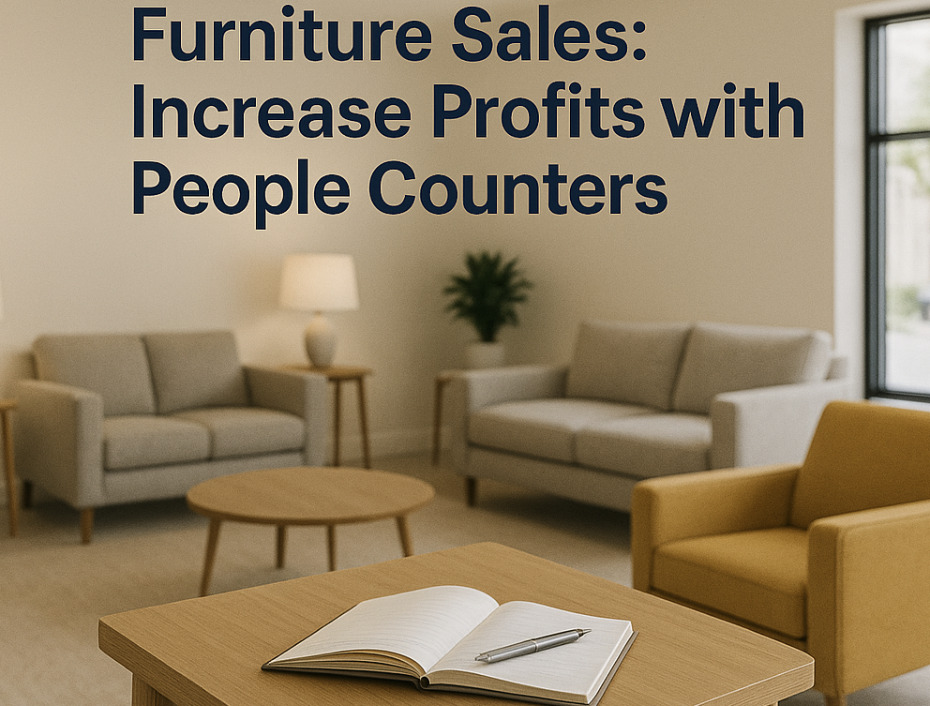In the world of furniture retail, staying competitive requires more than just quality inventory and attractive displays. With fluctuating foot traffic, evolving consumer behavior, and increasing competition from online marketplaces, brick-and-mortar furniture stores must leverage every possible advantage. One powerful — yet often underutilized — tool for boosting sales and operational efficiency is the people counter.
This article explores the fundamentals of using people counters in furniture sales and how they can directly increase profits. If you’re a furniture store owner, manager, or marketing professional, understanding and implementing people counting technology could be the game-changer your business needs.
Why Furniture Stores Need People Counters
Furniture sales differ from fast-moving consumer goods in several key ways:
- Longer sales cycles
- Higher ticket values
- Infrequent but intentional purchases
- Importance of in-store experience
Understanding your foot traffic is crucial in this environment. People counters give you the data to answer vital questions:
- How many people walk into your store each day?
- What times of day or days of the week are busiest?
- How effective are your marketing campaigns in driving visits?
- How many browsers are converting into buyers?
Without people counters, you’re guessing. With them, you’re making data-driven decisions.
Turning Foot Traffic into Profits
1. Optimize Staffing Levels
People counters help match staffing to demand. With accurate data on peak hours, you can ensure that enough sales staff are available when customers are most likely to need assistance. This prevents missed sales due to under-staffing and reduces labor costs during slower periods.
2. Measure Sales Conversion Rates
Combining people counter data with point-of-sale (POS) systems allows you to calculate conversion rates — the percentage of visitors who make a purchase. This is a critical metric:
If 100 people visit your store and 20 make a purchase, your conversion rate is 20%.
Once you know your baseline, you can experiment with store layout, sales training, promotions, and product placements to improve it.
3. Assess Marketing Effectiveness
If you’re investing in advertising — print, digital, radio, or even social media — you want to know if it’s working. People counters can show you traffic increases during campaigns. For example:
Did your Presidents’ Day sale bring in more people compared to last year?
Was there a spike in visits after running a Facebook ad?
This real-world feedback helps fine-tune marketing strategies for better ROI.
4. Improve Store Layout and Design
Do customers flow naturally through your showroom? People counting systems with heat mapping features can track movement through the store. This data reveals which areas get attention and which are overlooked, guiding better store layout and product placement.
5. Forecasting and Inventory Planning
Foot traffic patterns help predict future demand. If you know when traffic typically spikes (e.g., back-to-school season or year-end holidays), you can stock appropriately. Data-driven forecasting minimizes overstocking and understocking — both of which affect profitability.
Real-World Example: Boosting Sales Through Analytics
Let’s take a hypothetical mid-sized furniture retailer, “HomeStyle Interiors.” After installing people counters at two locations, they noticed something surprising: the suburban store had higher foot traffic than the downtown store but generated fewer sales.
By analyzing data, they discovered:
- The suburban location had lower staff engagement during peak hours.
- The downtown location had more experienced sales associates who closed better.
- Certain times of day had a higher “linger rate” — customers stayed longer when greeted early.
With this insight, HomeStyle Interiors adjusted staffing schedules, added a simple welcome protocol, and increased training in the suburban store. The result? A 15% increase in conversion rate within three months.
Best Practices for Implementing People Counters
If you’re considering integrating people counters into your furniture store, here are some best practices:
- Choose the Right Technology
For large showrooms with complex layouts, go with advanced AI or 3D sensors. For smaller spaces, basic infrared counters may suffice. - Integrate with Other Systems
Link people counter data with POS, CRM, and marketing tools for comprehensive insights. - Train Your Team
Make sure managers and staff understand the data and how to use it. Use KPIs to motivate performance, not to micromanage.Give them the tools to succeed and boost morale, - Monitor & Adjust
Review your traffic and conversion data regularly. Use it to run experiments — change your signage, rearrange furniture, or try a new sales approach — and see what moves the needle.
The Future of Furniture Retail: Smart, Data-Driven Decisions
People counting is more than a way to track visitors — it’s a business intelligence tool that reveals how your store is performing at its most fundamental level. In an age where margins are tight and customer expectations are high, using real-time data to inform staffing, marketing, and operations is no longer optional — it’s essential.
By investing in people counting technology and incorporating its insights into your daily operations, you position your furniture business for smarter decisions, better customer experiences, and, ultimately, increased profits.
The fundamentals of furniture sales are evolving. It’s no longer enough to simply hope for foot traffic and rely on intuition to guide decisions. With people counters, you gain measurable insight into customer behavior, optimize your sales process, and create opportunities for consistent growth.
For furniture retailers looking to stay ahead in a competitive market, people counting isn’t just a tool — it’s a strategic advantage.
Traxsales will provide you with the tools to manage and measure your foot traffic. With the help of TraxSales, retailers can implement high-accuracy people counting systems that go beyond just counting — they transform raw traffic data into actionable business intelligence. So that retailers can take the steps to help their business succeed. Book a demo with the President of Sales, Spencer Mink by calling 330-319-1445 today!


